Chemical recycling China export – China’s Exports Witnessed a Decline : Is this a bad sign for oil? 09-08-2023 - Arhive
Chemical recycling China export
Crude Oil Prices Trend
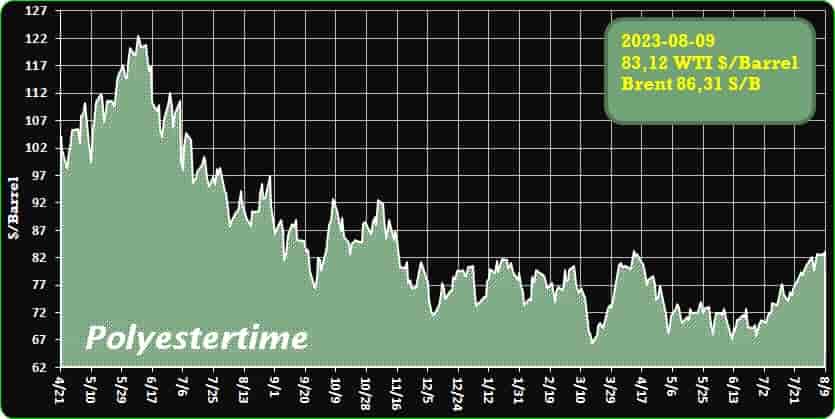
Crude Oil Prices Trend by Polyestertime
Toray Advanced Materials Korea Inc. (TAK) finds itself at a pivotal juncture as it contemplates an expansive move in its film production line within South Korea
In a remarkable departure from prevailing trends, the company has chosen to press forward with its ambitious plans, in stark contrast to its contemporaries in the chemical sector who have opted to curtail investments due to an industry-wide deceleration in the face of the ongoing economic downturn. This decision by TAK, despite the prevalent cautionary stance, underscores its resilience and strategic foresight.
Sources entrenched within the chemical industry landscape revealed a noteworthy development. Toray Group, a prominent Japanese chemical conglomerate, through its Korean arm, is meticulously scrutinizing the prospect of channeling investments into augmenting film production lines situated at its facility in Gumi, located within North Gyeongsang Province. Chemical recycling China export
This contemplative move, earmarked for the investment review’s culminating phase, demonstrates Toray’s commitment to redefining the trajectory of its operations, defying the prevalent pessimism clouding the global economic landscape.
In a climate where industry peers have sought refuge in tactics such as divesting their film-centric enterprises or consciously moderating their film line capacities in response to the waning global appetite for televisions and similar appliances, Toray’s unwavering stance to bolster its film business reverberates with strategic acumen. The persistent specter of the economic downturn has cast a pall over the consumer electronics domain, prompting many to adopt a more conservative stance in resource allocation. This prevailing sentiment dictates that during economic upswings, petrochemical entities open their coffers to expand their operational capabilities. However, when confronted with a downturn, they exercise restraint, conserving resources for prospective ventures that lie on the horizon. Chemical recycling China export
This intriguing divergence in Toray’s trajectory gains further significance when examined within the broader context of the Korean chemical landscape. With the rise of their Chinese counterparts as aggressive expansionists, Korean chemical firms have tread cautiously, mindful of their burgeoning capabilities aimed at diminishing their reliance on imports. This stark juxtaposition, marked by China’s unwavering expansionism and Korea’s measured introspection, shapes the foundation upon which Toray’s decision rests.
Taking a step back, Toray Advanced Materials had earlier unveiled a strategic blueprint that echoes its ambitious vision. A comprehensive scheme involving the amplification of annual polyphenylene sulfide (PPS) resin production capacity by a substantial 5,000 tons at its Gunsan facility in North Jeolla Province was put forth in February. This superlative engineering plastic resin, celebrated for its formidable heat resistance, strength, chemical resilience, and processability attributes, is indicative of Toray’s unwavering commitment to pushing the boundaries of innovation and carving out a niche in the competitive chemical market. Chemical recycling China export
In retrospect, Toray Advanced Materials Korea Inc.’s contemplation of an expansive foray into its film line production within South Korea emerges as a decision that diverges from the conventional. Amidst an industry climate riddled with hesitancy and financial prudence in the face of economic adversity, Toray’s resolute stance underscores its strategic resilience. In a milieu where competitors are either retreating from the film sector or cautiously curtailing their capacities, Toray’s forward-looking approach shines as a beacon of determination. This strategic choice, set against the backdrop of Korea’s intricate chemical landscape, resonates with the ongoing expansionist tide of Chinese counterparts and the measured approaches of Korean players. Toray’s pursuit of growth exemplifies its commitment to defying norms and shaping its destiny amidst the complexities of the global economy. Chemical recycling China export
As the chemical industry navigates the crosscurrents of uncertainty, Toray Advanced Materials’ audacious step stands as a testament to the power of strategic sagacity. In a landscape where economic winds blow unpredictably, Toray’s unwavering investment in the future echoes its belief in the promise of innovation and growth.
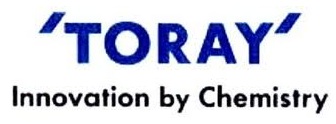

China’s exports have experienced a significant downturn, plummeting by 14.5% in July when compared to the same period the previous year
This downturn is placing increased pressure on the ruling Communist Party to take action in order to reverse the ongoing economic decline.
The impact of this decline is widespread, as imports also suffered a substantial drop of 12.4%, as indicated by customs data released on Tuesday. This downturn in imports delivers a blow to global exporters who rely on China as one of the largest markets for a wide array of industrial materials, food products, and consumer goods.
The value of exports in July shrank to $281.8 billion, and this decline gathered pace compared to the previous month’s 12.4% decrease. Concurrently, imports dwindled to $201.2 billion, marking a widening contraction from the 6.8% contraction observed in the preceding month. Chemical recycling China export
These trends have resulted in a significant change in China’s global trade surplus. It has narrowed by 20.4% compared to the same period a year ago, now standing at $80.6 billion, a considerable drop from the record high seen previously.
The Chinese government is now confronted with the challenge of revitalizing both business and consumer activities, following an initially promising rebound after the easing of pandemic-related restrictions in December. However, this revival was short-lived and did not meet expectations.
The economic repercussions are evident, with a decline in economic growth to a mere 0.8% in the second quarter of the year. This is a stark contrast to the 2.2% growth observed in the January-March period, equating to an annual growth rate of 3.2%, a figure that ranks among China’s lowest in the past thirty years.
A contributing factor to this economic slump has been the cooling demand for Chinese exports, stemming from the decision of the Federal Reserve and central banks in Europe and Asia to raise interest rates in an effort to combat inflation that had reached multi-decade highs.
Capital Economics has highlighted that this contraction in exports marks the most significant decline since the initiation of the COVID-19 pandemic in 2020. Notably, this decline is primarily attributed to falling prices, while the volume of goods traded remains above levels recorded before the pandemic outbreak. Chemical recycling China export
Experts anticipate that the decline in exports will persist over the coming months, likely reaching its lowest point by the end of the year. This projection is partly due to the challenging near-term outlook for consumer spending in developed economies.
The Chinese government has outlined plans to support entrepreneurs, stimulate home purchases, and encourage consumer spending. Yet, it has not yet unveiled plans for extensive stimulus spending or significant tax cuts. While these measures are expected to eventually rekindle demand for imports, the recovery is predicted to be gradual.
The deterioration of domestic demand is a pressing concern, prompting David Chao of Invesco to highlight the need for further policy support to invigorate household spending, potentially leading to improved import growth in the forthcoming months.
Specifically, trade dynamics with key partners demonstrate the extent of the challenges faced. Exports to the United States experienced a drastic decline of 23%, amounting to $42.3 billion, while imports of American goods contracted by 11.1% to $12 billion. This shift caused China’s trade surplus with the United States to decrease by 27% to $30.3 billion.
Exports to Russia, largely consisting of oil and gas, experienced a marginal reduction of 0.1% compared to the previous year, totaling $9.2 billion. These imports help counterbalance the loss of revenue caused by Western sanctions imposed due to Russia’s actions in Ukraine.
In contrast, trade relations with the European Union have experienced a significant setback. Exports to the EU plummeted by 39.5% year-on-year, reaching $42.4 billion. Imports of European goods were also adversely impacted, declining by 44.1% to $23.3 billion, causing China’s trade surplus with the EU to contract by 32.7% to $19.1 billion.
In cumulative terms, the first seven months of the year saw Chinese exports decrease by 5% compared to the same period in the previous year, totaling just over $1.9 trillion. Simultaneously, imports were down 7.6%, amounting to $1.4 trillion.
The ramifications of these economic shifts are far-reaching, requiring the Chinese government to implement measures that address the decline in both exports and imports, aiming to foster sustainable economic growth. Chemical recycling China export
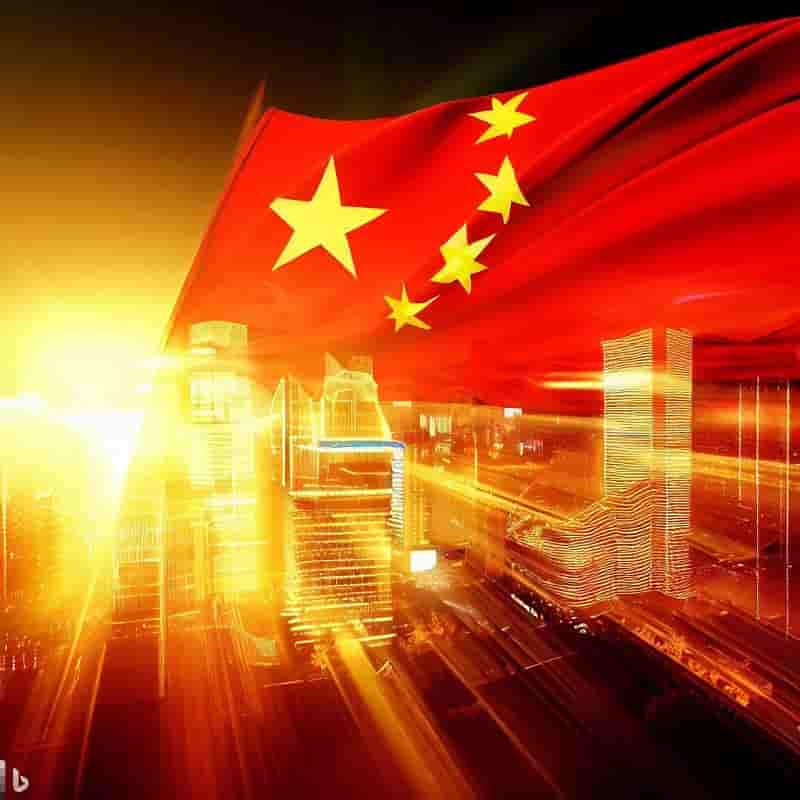
Chemical recycling makes sense whenever mechanical recycling falls short
But: cannibalising of material streams must be avoided
In its ‘Let’s talk about Chemical Recycling” series, the Plastics and Rubber Machinery division of the German VDMA association talks to experts and stakeholders active in the chemical recycling space. Here, Michael Ludden, managing director of Sutco Recycling GmbH stresses the need to regulate material streams: “There must not be a cannibalisation of material flows”. Chemical recycling China export
Mr. Ludden, what potential does chemical recycling have in your view?
The potential is clearly between mechanical processing and energy recovery. When incinerating, only the energy of the plastic waste is used, the material itself is lost; therefore, new material has to be obtained from fossil resources. But unlike mechanical recycling, chemical recycling breaks down these compounds instead of utilising existing polymers as material.
In practice, in which area is it feasible?
For me, chemical recycling becomes feasible whenever mechanical recycling proves difficult. It makes sense to break up the carbon compounds, clean them and polymerise them again. That is not taking place at the moment, however. Unfortunately, the crux of the matter is that chemical recycling currently only deals with reprocessing of polyolefins such as polypropylene and polyethylene. These plastics consist only of chains made up of carbon and hydrogen. The large amount of other plastics that also contain nitrogen, sulphur or oxygen is not the focus of chemical recyclers, because these substances interfere with pyrolysis. However, polyolefins can be processed very well in mechanical recycling. This type of recycling is ecologically much more sensible because the plastics remain intact in their composite structure. Firstly, no material is destroyed, and secondly, fewer resources, less energy and less water are required for reprocessing. If chemical recyclers now also use the material that the mechanical recyclers can process very well, this will lead to a cannibalisation of the material flows.
This must be prevented at all costs. Chemical recycling China export
With which approach?
It is the task of politics to prevent this. In principle, there is a legally defined five-level waste hierarchy. Mechanical recycling is of higher value than chemical recycling. This principle must not be disrupted. Efforts to sync mechanical and chemical recycling are already underway; however, in my view, this is very dangerous, as it would have a considerably negative impact on the environment. However, the environment must always be the main priority.
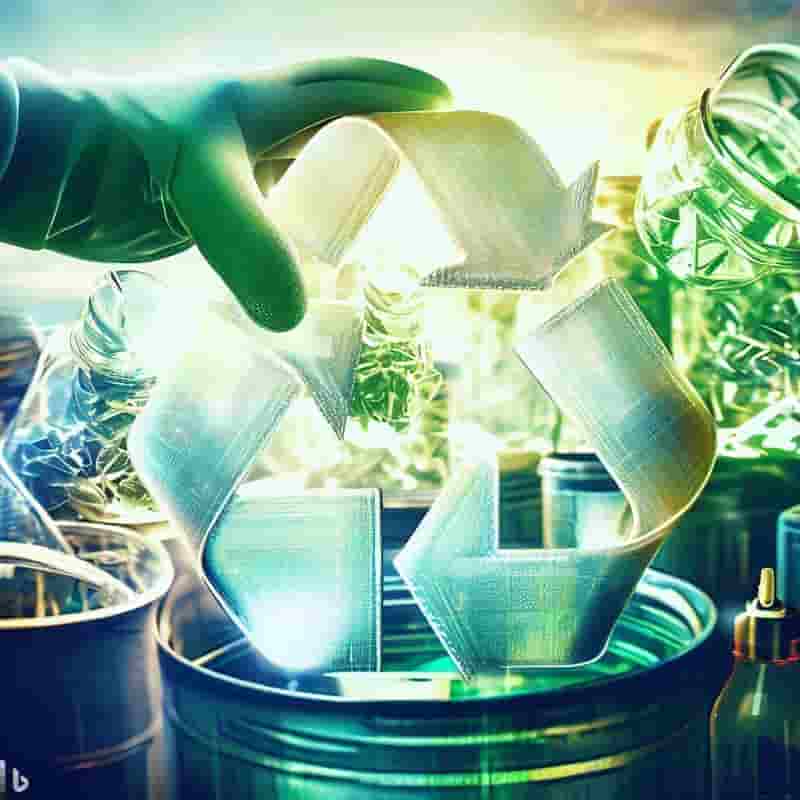
The VCI association, representing the German chemical industry, has unveiled its disconcerting findings for the initial half of the year, indicating a severe setback in production
Excluding pharmaceuticals, overall production tumbled by a staggering -16.5% in comparison to the same period in the preceding year. Notably, polymers and petrochemicals bore the brunt of this downturn, plummeting by -19% and -21% respectively. The utilization of production capacities averaged a meager 77%, underscoring the prevalent challenges.
Markus Steilemann, an influential figure as the president of VCI and the CEO of Covestro, succinctly encapsulated the grim reality: “The appetite for chemical products is waning. The statistics from the first half of the year paint a bleak picture, while Germany grapples with non-competitive production costs.” Unfortunately, the forecast remains bleak for the latter half of the year, prompting VCI to revise its 2023 projections downward—anticipating a drop of -8% with pharmaceuticals and a steeper decline of -11% without. With prices languishing, sales are predicted to plummet by -14%. Chemical recycling China export
Expanding on the scenario for the initial half of 2023, the chemical-pharmaceutical sector’s revenues experienced a sharp downturn of -11.5%, amounting to 114 billion euros. This unsettling trend manifested as a -15.5% decrease in the domestic market and a slightly less severe decline of -8.5% internationally.
A comprehensive survey among VCI’s member companies shed light on the alarming challenges faced by the industry. A significant two-thirds of the participating firms reported shrinking profits or even outright losses. This troubling trend is attributed to the unrelenting pressure on prices juxtaposed with sustained high production costs. The situation is further exacerbated by the lackluster demand on global markets, contributing to the prevailing adversity.
However, the specter of a global market recession is not the sole concern plaguing the German chemical industry. Markus Steilemann expounded on the issue, highlighting the dwindling confidence in Germany’s attractiveness as a business destination. This disenchantment is fueled by a combination of exorbitant energy prices, cumbersome taxation, inadequate infrastructure, a scarcity of skilled workers, sluggish digitization efforts, and an overabundance of bureaucratic red tape. Chemical recycling China export
A striking 90% of the survey’s respondents found energy costs to be a hindrance, if not a detriment, when compared on an international scale. Markus Steilemann underscored the significance of competitive electricity costs for the chemical sector, emphasizing that even though they have seen a decrease, they still linger above pre-crisis levels—ultimately impeding those operating within Germany. The sentiment regarding bureaucratic hurdles and regulatory encumbrances has also deteriorated, with a staggering 8 out of 10 respondents considering these factors as detrimental to business in Germany, a threshold not reached in the past.
Markus Steilemann concluded by emphasizing the chemical industry’s pivotal role as the “first domino to swing.” He articulated that if the industry’s prospects falter at the inception of the value chain, a cascade effect could ripple through other sectors. A robust chemical industry is indispensable for Germany’s success in navigating structural transformation. Chemicals serve as the enabler for essential technologies, such as batteries, chips, semiconductors, and the transitions in energy and mobility.
In light of these mounting challenges, VCI is actively urging the government to outline an industrial plan extending until 2030. The objective is to enhance international competitiveness and stave off the relegation of the German industry. As the situation calls for proactive measures, the industry’s plea resonates with the need for a concerted effort to secure a brighter future for Germany’s chemical sector. Chemical recycling China export
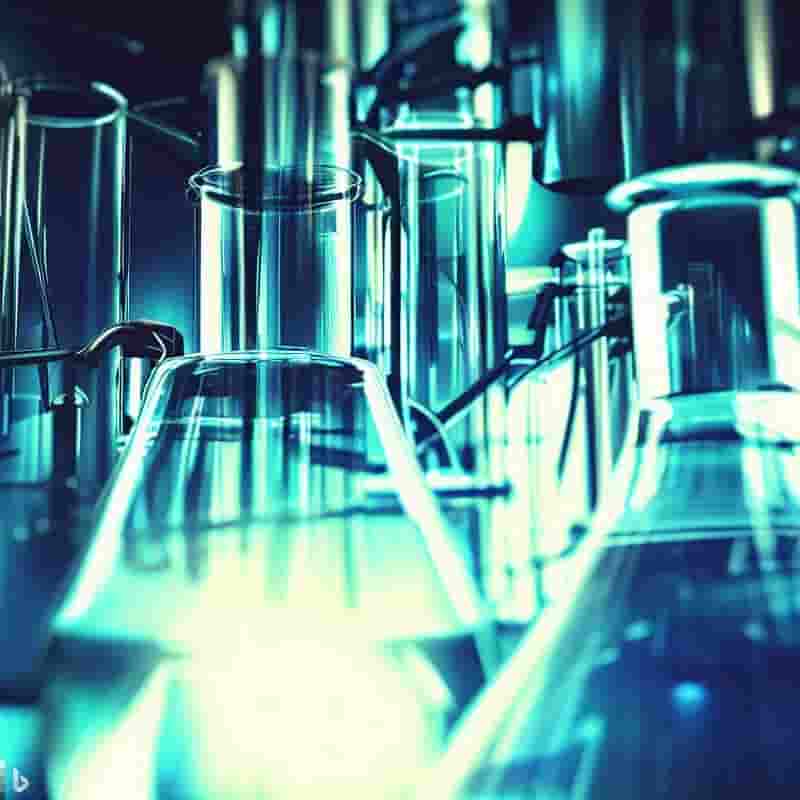
A groundbreaking revelation has emerged from recent research: the potential to harness energy from the atomic motion within a single layer of graphene
This scientific breakthrough could usher in a new era of energy production, particularly in the realm of low-power batteries, holding significant promise for the development of sustainable electronic devices and sensors. The innovative study, carried out by scholars at the University of Arkansas, has successfully engineered a circuit capable of tapping into the energy generated by graphene’s atomic movements, thus setting the stage for potential revolutionary applications. Chemical recycling China export
Graphene, the remarkable substance consisting of a lone layer of carbon atoms, has once again taken the spotlight due to the pioneering work conducted at the University of Arkansas. The research team has designed a circuit that exploits the inherent kinetic energy of graphene’s atoms to produce electricity. While the current energy output remains modest, this technology’s implications are far-reaching, hinting at the prospect of remarkably efficient low-power batteries, a crucial advancement particularly valuable for sensor applications.
Published in the prestigious journal Physical Review E, the study stems from a theory formulated by the same group of physicists. The theory posits that the intricate ripples and movements of individual carbon atoms within graphene can be harnessed to generate energy. Remarkably, this theory challenges established thermodynamic principles, particularly the second law, which asserts that heat naturally flows from a hotter body to a colder one.
Central to this discovery is a complex theoretical framework that challenges traditional conceptions of thermodynamics. In the past, it was widely accepted that deriving usable work from Brownian motion—essentially, the random motion of particles—was an insurmountable feat. However, the researchers defied expectations and achieved a remarkable outcome: at room temperature, the inherent thermal motion of graphene atoms induces an alternating current within the circuit. Chemical recycling China export
To enhance the circuit’s efficiency, the researchers integrated two diodes, which adeptly convert the alternating current into direct current. Strikingly, contrary to initial assumptions, these diodes amplify power output instead of diminishing it. Lead physicist Paul Thibado noted that this ingenious solution led to a notable augmentation in the amount of generated power.
The research has unveiled a symbiotic connection between graphene and the circuit itself. Despite the influence of the thermal environment on load resistance, the material and the circuit maintain equilibrium at the same temperature, with no transfer of heat between them. Furthermore, the gradual, deliberate motion of graphene atoms yields current at low frequencies, thereby augmenting the circuit’s overall efficiency.
A forthcoming challenge involves assessing the viability of storing direct current in a capacitor for future utilization. Should this potential be realized, the door could open for the construction of myriad graphene-based circuits on a single chip—a revolutionary departure from conventional low-power batteries that currently energize small-scale devices and sensors. Chemical recycling China export
This revelation of a circuit capable of harnessing energy from the atomic movements of graphene constitutes a momentous stride in the realm of energy research. Beyond merely demonstrating the feasibility of graphene as an energy generator, this achievement lays the groundwork for prospective practical applications. The impending task involves devising technologies to effectively store the energy generated and the development of expansive circuits on a larger scale. Anticipations are high that this breakthrough will transform the landscape of electronic device power supply, ushering in sustainable solutions characterized by minimal energy consumption and offering a tangible avenue for financial savings.

Origin Materials and Terphane have joined forces to advance the development of biaxially oriented PEF (polyethylene furanoate) films, as stated by the companies
Origin Materials, a prominent player in carbon negative materials, is dedicated to facilitating the shift towards sustainable materials globally. Teaming up with Terphane, a division of Tredegar Corporation and a key player in specialty PET polyester films (BOPET), the collaboration aims to create high-performance bio-polymer films with sustainability at their core. Chemical recycling China export
As a pivotal aspect of this partnership, Terphane has inked a multi-year agreement to secure capacity for purchasing the advanced bio-polymer PEF. This innovative material will be employed in a variety of film applications, including packaging for food and beverages, along with high-value industrial uses. These films, referred to as BOPEF (biaxially oriented PEF), and the well-known BOPET (biaxially oriented PET), are recognized for their remarkable attributes such as strength, transparency, barrier capabilities, and electrical insulation.
Rich Riley, Co-CEO of Origin Materials, expressed enthusiasm for collaborating with Terphane, a globally recognized leader in films with a wide-reaching network of customers and partners. The objective is to collectively craft high-performance products that foster the advancement of a net zero material economy. This venture is a significant stride forward in Origin’s commitment to facilitating the world’s transition to sustainable materials. Chemical recycling China export
According to Marcos Vieira, Terphane’s Global Director of R&D, the development of these films holds vital importance in meeting the burgeoning global demand for sustainable flexible packaging solutions. The film, partially composed of PEF, retains all the conventional traits of standard PET films, including the ability for post-consumer recycling. Moreover, PEF boasts exceptional thermal resistance and superior barrier performance, thereby extending the shelf life of packaged goods. Initial tests conducted in the United States have demonstrated the material’s compatibility with extrusion lines.
Origin Materials’ patented technological platform has the potential to revolutionize the commercialization of cost-effective and low-carbon PEF. Derived from furandicarboxylic acid (FDCA), a key precursor to PEF, Origin PEF emerges as a polymer that harmoniously blends sustainability and performance aspects, particularly in packaging, where heightened barrier attributes are essential. Origin’s PEF is projected to be entirely plant-based and fully recyclable, boasting compelling economic viability while significantly reducing carbon footprint.
Its superior strength, thermal properties, and barrier performance outshine those of conventional petroleum-based materials. Chemical recycling China export
It’s worth noting that Origin Materials, a front-runner in carbon negative materials, is steadfast in its mission to drive the global shift towards sustainable materials. A notable partnership milestone was also reached between Origin Materials and Husky Technologies, a pioneering provider of essential solutions to the worldwide community. This milestone pertained to the commercialization of PET (polyethylene terephthalate) infused with the sustainable chemical FDCA (furandicarboxylic acid), targeting advanced packaging and various other applications.

Column: Should We Call it Advanced, Chemical, or Molecular Recycling?
What’s in a name? It depends on who you ask, but “advanced” seems to be emerging as the preferred descriptor of a host of new recycling technologies. Let’s find out how the public views them. Chemical recycling China export
Editors at Packaging World have kicked around the idea of standardizing on one descriptor—among advanced, chemical, or molecular—to refer to a host of burgeoning recycling technologies that tend to revolve around (but aren’t limited to) depolymerization via pyrolysis, gasification, or solvents. My instinct was to default to “chemical” recycling, the earliest common descriptor. But “advanced” is an inclusive umbrella term that doesn’t carry the negative connotation baggage that some say the word “chemical” elicits. Meanwhile, “molecular” limits conversation to the depolymerization set of technologies, thus omitting methods like PureCycle polypropylene recovery. As PureCycle’s Matt Cripe explained to me at the recent MRP Solutions Sustainability Summit near Chicago, the tech cleans PP to virgin quality, but it doesn’t break it down to a monomer. Anyhow, PW will hold off on standardizing on a single descriptor for now.
This minor editorial conundrum is a microcosm of the public relations problem faced by advanced recycling (I guess I’m going with “advanced”). A big source of negative press has come from Senator Corey Booker (D-NJ) and other legislators who, in my opinion, have oversimplified pyrolysis and gasification (advanced recycling methods), labeling them as incineration instead of recycling to focus on CO2 byproducts. They aim to convince the Environmental Protection Agency (EPA) to keep considering these techs municipal waste combustion, and thus regulate them under the Clean Air Act. The experts tend to wear down non-expert legislators over time, so I’m hoping a course correction will occur. Or, as my buddy Eric Greenberg suggests on page 42, maybe agencies like the EPA won’t have such sharp teeth before long. Chemical recycling China export
I heard advanced recycling’s PR travails laid bare in Orlando last month at the American Chemistry Council’s Innovation & Circularity Summit, in a panel discussion on the so-called mass balance approach, third-party certification for credibility, and ongoing consumer education.
Advanced recycling technologies often rely on the mass balance approach—a process of describing and accounting for the use of advanced recycled or bio-based feedstock in a final product when both recycled and virgin feedstock, or bio-based and fossil feedstock, have been used in the process. Since advanced recycling is a nascent tech, it’s not often practical for a usage figure to get even close to 100%, given chemically recycled PCR’s scarcity. So the approach is a matter of averages. Some of that chemically recycled material comes into a brand or producer facility, and some of it leaves the facility as packaging. The mass balance just accounts for how much of it is used as a part of the whole. This means the shampoo bottle with a claim that it is made from 30% advanced recycled PCR may not contain any, or perhaps more or less. But the company that produced it is indeed using that percentage of that material over a given product line.
But the mass balance approach and its traceability underpinnings require validation for credibility, said certification provider and converter panelists at the Innovation & Circularity Summit. Chemical recycling China export
Overcoming CPG skepticism of the tech while educating consumers is key, according to early adopter converters who were there, like Berry Global.
To the uninitiated, claims based on technical-sounding terms like the mass balance approach can seem like smoke and mirrors. But other industries have gone through the same rounds of skepticism long before advanced recycling’s (and bio-based plastics’) mass balance approach. Carbon credits and carbon offsets, for instance, or even clean energy credits in powering peoples’ homes, were once seen as a means of fudging the numbers to make unrealistic claims. But as consumers and their energy, travel, and brand suppliers became more acquainted with those concepts, they largely have come around. After some education- and understanding-borne confidence, these systems enjoy widespread credibility today. Chemical recycling China export

Chemical recycling China export
